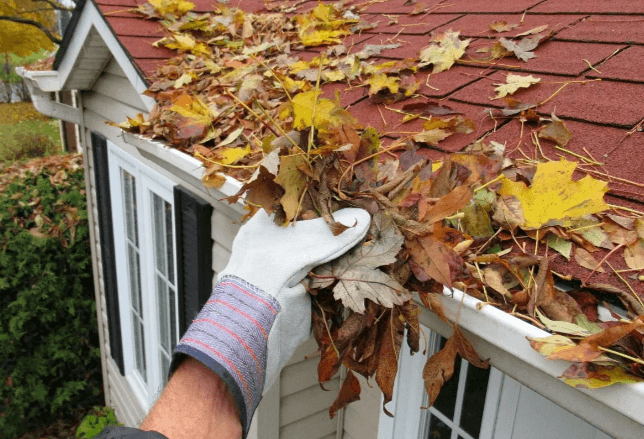
DIY Gutter Cleaning Tips and Tricks
Introduction
Gutters play a crucial role in protecting your home from water damage by directing rainwater away from your roof and foundation. Over time, however, leaves, twigs, and other debris can clog gutters, leading to overflow, leaks, and even structural damage. Regular maintenance is essential to ensure that your gutters remain clear and functional, especially before and after heavy rainfall seasons.
While hiring a professional to clean your gutters is always an option, DIY gutter cleaning can save you money and give you peace of mind knowing the job is done right. In this guide, we will walk you through the best DIY gutter cleaning tips and tricks, from safety precautions to the tools you’ll need, and step-by-step instructions for keeping your gutters in top shape.
Importance of Regular Gutter Maintenance
Keeping your gutters clean is about more than just aesthetics. Neglecting this task can lead to serious problems that may require costly repairs. Blocked gutters can cause water to overflow, leading to issues like roof damage, basement flooding, and soil erosion around your foundation. Moreover, standing water in clogged gutters can become a breeding ground for pests like mosquitoes.
Regular gutter maintenance prevents these issues by ensuring that water flows freely through your gutter system, protecting your home from potential water damage. By making gutter cleaning a routine part of your home maintenance, you can extend the life of your roof, preserve your home’s foundation, and avoid expensive repairs down the line.
Understanding Your Gutter System
Before diving into the cleaning process, it’s important to understand the components of your gutter system and how they work together. Typically, a gutter system includes:
- Gutters: Horizontal channels installed along the edge of your roof that collect and direct rainwater.
- Downspouts: Vertical pipes that carry water from the gutters down to the ground level.
- Elbows: Angled pieces that connect gutters to downspouts and help direct water away from your home.
- End caps: Pieces that close the ends of the gutters to prevent water from escaping.
Understanding these parts will help you identify potential problem areas during your cleaning process, such as leaks, sagging gutters, or disconnected downspouts.
Safety Precautions for DIY Gutter Cleaning
Safety should be your top priority when undertaking any DIY project, and gutter cleaning is no exception. Here are some essential safety tips to keep in mind:
- Use a sturdy ladder: Always use a stable, extendable ladder that can reach the height of your gutters. Make sure the ladder is on a flat, stable surface before climbing.
- Wear protective gear: Gloves, safety goggles, and long sleeves are essential to protect your hands, eyes, and skin from debris, sharp edges, and pests.
- Have a spotter: If possible, have someone hold the base of the ladder while you work to provide additional stability.
- Avoid working alone: It’s safer to have someone nearby in case of an emergency.
- Check the weather: Avoid cleaning gutters during or after rain when surfaces are slippery. Ideally, choose a dry day with calm weather.
Essential Tools for Gutter Cleaning
To make the gutter cleaning process easier and more effective, you’ll need the right tools. Here’s a list of must-have items for your DIY gutter cleaning toolkit:
- Ladder: A tall, stable ladder is essential for reaching gutters safely.
- Gloves: Durable gloves will protect your hands from sharp debris and dirty water.
- Gutter scoop: A small plastic scoop or a trowel is perfect for removing debris from gutters.
- Garden hose: A garden hose with a spray nozzle helps flush out remaining debris and test water flow.
- Bucket: Use a bucket to collect debris and prevent a mess in your yard.
- Tarp: Lay a tarp on the ground below to catch falling debris and make cleanup easier.
- Plumber’s snake: This tool is useful for clearing clogs in downspouts.
Step-by-Step Gutter Cleaning Process
Cleaning your gutters may seem like a daunting task, but it’s relatively simple if you follow these steps:
- Set up your ladder: Place your ladder on a stable surface, ensuring it’s secure before climbing. Make sure you have all your tools within easy reach.
- Remove debris: Start by scooping out loose debris from the gutters using your hands or a gutter scoop. Work your way along the length of the gutter, disposing of debris into a bucket or onto a tarp below.
- Flush with water: After removing the bulk of the debris, use a garden hose to flush out any remaining dirt and small particles. This will also help you identify any leaks or areas where water isn’t flowing properly.
- Clear downspouts: Check that downspouts are clear by running water through them. If water doesn’t flow freely, use a plumber’s snake to remove any blockages.
- Inspect for damage: As you clean, take the opportunity to inspect your gutters for signs of damage, such as rust, sagging, or loose brackets. Make necessary repairs to ensure your gutters are in good condition.
Tips for Preventing Gutter Clogs
While regular cleaning is essential, there are several steps you can take to reduce the frequency of gutter clogs:
- Install gutter guards: These protective covers allow water to enter the gutter while keeping out leaves and debris. Gutter guards can significantly reduce the need for frequent cleaning.
- Trim overhanging branches: Trees with branches that hang over your roof can drop leaves and twigs into your gutters. Regularly trimming these branches can minimize debris buildup.
- Regularly check and clean: Even with preventive measures, it’s important to check your gutters at least twice a year—once in the spring and again in the fall. Clean as needed to prevent clogs.
Seasonal Gutter Cleaning Considerations
Different seasons present unique challenges for gutter maintenance. Here’s what you should keep in mind throughout the year:
- Spring: Springtime often brings rain and new plant growth, which can contribute to gutter clogs. After the last frost, clean out your gutters to prepare for spring showers.
- Summer: Summer is a good time to check your gutters for any damage sustained during spring storms. Clear any debris that may have accumulated during the season.
- Fall: Falling leaves are the biggest concern during autumn. Clean your gutters after the trees have shed their leaves to prevent winter clogs.
- Winter: Ice dams can form in gutters during the winter, leading to water backup and damage. Ensure gutters are clear before the first snowfall and consider using heat tape to prevent ice buildup.
How to Handle Stubborn Gutter Clogs
Sometimes, debris can become compacted or stuck in your gutters, creating stubborn clogs. Here’s how to tackle these tough blockages:
- Soak and loosen: If debris is compacted, try soaking it with a garden hose to soften it. This will make it easier to remove with a scoop or your hands.
- Use a plumber’s snake: For clogs in downspouts, a plumber’s snake can help break up and remove the blockage. Insert the snake into the downspout and turn the handle to dislodge the debris.
- Pressure washer: If you have access to a pressure washer, it can be an effective tool for blasting away tough clogs. Be cautious when using high pressure to avoid damaging your gutters.
Signs Your Gutters Need Cleaning
Recognizing the signs that your gutters need cleaning can prevent problems before they escalate. Watch for these indicators:
- Overflowing water: If water is spilling over the sides of your gutters during a rainstorm, it’s a clear sign that they’re clogged and need cleaning.
- Sagging gutters: The weight of accumulated debris can cause gutters to sag or pull away from the house. This requires immediate attention to prevent further damage.
- Water damage: Look for signs of water damage on your home’s exterior, such as peeling paint, rotting wood, or mold growth. These could indicate that your gutters aren’t draining properly.
- Pests: If you notice an increase in pests like mosquitoes or birds around your gutters, it could be due to standing water or debris buildup.
Common Gutter Cleaning Mistakes to Avoid
When cleaning your gutters, it’s important to avoid these common mistakes to ensure effective results and prevent damage:
- Ignoring safety: Failing to use a stable ladder or neglecting protective gear can lead to accidents. Always prioritize safety during your DIY projects.
- Using the wrong tools: Using tools that are too large or not designed for gutter cleaning can damage your gutters. Stick to the recommended tools for the job.
- Neglecting downspouts: Cleaning gutters but forgetting to check downspouts can leave blockages that cause water to back up. Always ensure downspouts are clear.
- Postponing repairs: If you spot damage during cleaning, address it immediately. Ignoring minor issues can lead to more significant problems over time.
DIY Gutter Cleaning vs. Professional Services
While DIY gutter cleaning can save you money, there are situations where hiring a professional might be the better option. Here’s a comparison to help you decide:
- DIY Gutter Cleaning:
- Pros: Cost-effective, can be done on your schedule, and allows you to inspect your gutters for damage.
- Cons: Time-consuming, requires physical effort and some risk, especially if you’re not comfortable on a ladder.
- Professional Gutter Cleaning:
- Pros: Quick and efficient, performed by experienced workers, and often includes a full inspection and minor repairs.
- Cons: More expensive than DIY, and scheduling may not be as flexible.
Consider the condition of your gutters, your physical ability, and your comfort level with heights when deciding whether to DIY or hire a pro.
Maintaining Gutters Year-Round
Proper gutter maintenance is a year-round task. To keep your gutters in peak condition, follow these tips:
- Regular inspections: Check your gutters at least twice a year and after any major storms. Look for signs of damage, blockages, and water flow issues.
- Install gutter guards: Gutter guards can reduce the amount of debris that enters your gutters, making maintenance easier and less frequent.
- Trim nearby trees: Regularly trim back branches that overhang your roof to prevent leaves and twigs from clogging your gutters.
- Repair damage promptly: Address any damage you find during inspections immediately to prevent more significant issues later on.
How to Repair Damaged Gutters
Over time, gutters can develop issues such as leaks, holes, or sagging. Here’s how to fix common gutter problems:
- Leaking joints: Apply gutter sealant to any leaking seams or joints. Make sure the area is clean and dry before applying the sealant.
- Holes: For small holes, use gutter patch kits that typically include a patch and adhesive. Larger holes may require replacing a section of the gutter.
- Sagging gutters: If your gutters are sagging, check the hangers or brackets that hold them in place. Tighten loose screws or replace damaged brackets to secure the gutter.
How Often Should You Clean Your Gutters?
The frequency of gutter cleaning depends on several factors, including the number of trees near your home and the weather patterns in your area. Generally, it’s recommended to clean your gutters at least twice a year, in the spring and fall. However, if you live in a heavily wooded area, you may need to clean them more frequently, such as every three months.
Additionally, after any major storm, it’s a good idea to check your gutters for debris and damage, even if it’s not part of your regular cleaning schedule.
Preventing Gutter Damage During Cleaning
Gutters are delicate structures that can be easily damaged during cleaning if you’re not careful. Here’s how to prevent accidental damage:
- Avoid harsh tools: Use plastic gutter scoops or your hands to remove debris, rather than metal tools that can scratch or dent the gutters.
- Don’t over-tighten brackets: When securing gutters, ensure that brackets are snug but not so tight that they warp or bend the gutter.
- Be gentle with downspouts: When clearing clogs, be cautious not to force tools or hoses into downspouts, which could cause cracks or dislodgment.
Why Clean Gutters Before Winter?
Cleaning your gutters before winter is crucial to prevent the formation of ice dams. When gutters are clogged, water can accumulate and freeze, creating a barrier that prevents additional water from draining. As the ice builds up, it can cause water to back up under your roof shingles, leading to leaks and water damage inside your home.
By ensuring that your gutters are clear of debris before the first freeze, you can avoid the risks associated with ice dams and protect your home from winter weather.
FAQs
How often should gutters be cleaned? Gutters should be cleaned at least twice a year, in the spring and fall. However, homes in heavily wooded areas may require more frequent cleaning.
Can I clean gutters without a ladder? While it’s possible to clean gutters from the ground using specialized tools, such as telescoping gutter cleaners, using a ladder provides a more thorough clean and allows you to inspect your gutters more closely.
What are gutter guards, and do they work? Gutter guards are covers that go over your gutters to keep out debris while allowing water to flow through. They can significantly reduce the frequency of gutter cleaning, but they aren’t foolproof and may still require occasional maintenance.
Is it safe to clean gutters in the rain? It’s best to avoid cleaning gutters in the rain, as wet surfaces can be slippery and increase the risk of accidents. Always choose a dry day for gutter cleaning.
What should I do if my gutters are leaking? If your gutters are leaking, check the seams and joints for cracks or gaps. Apply a gutter sealant to the affected areas to stop the leak.
Can clogged gutters cause roof damage? Yes, clogged gutters can cause water to back up and overflow, leading to damage to your roof, fascia, and soffits. Regular cleaning helps prevent this type of damage.
Conclusion
Gutter cleaning might not be the most glamorous home maintenance task, but it’s one of the most important. By keeping your gutters free of debris and in good repair, you protect your home from water damage, extend the life of your roof, and avoid costly repairs. With the right tools, safety precautions, and a little elbow grease, you can tackle this task yourself and keep your home in top condition year-round.
Remember, the key to effective gutter maintenance is regular cleaning and prompt repairs. Whether you choose to go the DIY route or hire a professional, staying on top of your gutters will ensure they continue to do their job of protecting your home from the elements.




